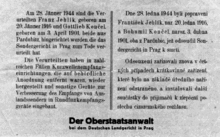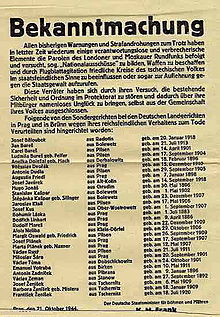Prague Special Court
The Prague Special Court was established in 1940 at the German Regional Court in Prague , the legal basis being the “Ordinance of the Reich Government on the Formation of Special Courts of March 21, 1933” (RGBl. I 1933 No. 24 p. 136). Other special courts in the occupied territory of Czechoslovakia worked in Eger (Cheb) , Litoměřice (Litoměřice), Troppau (Opava) and Brno (Brno).
The members of the Senate of the Special Court came from the criminal division of the Prague Regional Court. The competence of the special court was continuously increased, so that in 1943 it was responsible for all criminal offenses with the exception of espionage , state treason and high treason , while the exceptions were negotiated before the so-called People's Court .
history

Year after year the number of cases negotiated at the Prague Special Court increased:
- 1941 - about 100 cases
- 1942 - about 1,800 cases
- 1943 - about 2,400 cases
- 1944 - about 2,250 cases
- 1945 in the first four months - about 500 cases
The number of people convicted can no longer be precisely determined. In some cases, thirty or more people have been charged. With the expansion of the competencies of the special court, the number of senates also grew. In 1944 there were already six senates at the Prague Special Court, four of which were permanent and two were extraordinary senates. These extraordinary senates worked in the so-called " fast-track process ", with two days determining the whole process: the day of the arrest and the day of the sentencing, followed by the immediate execution .
The Extraordinary Senates of the Special Court in Prague also judged outside of Prague. Local residents were also forced to participate. This was intended to intimidate the local population. In German circles these trials were called " show trials ".
The senates of the special court consisted of three members: a chairman and two adjunct judges. From late 1943 on, the Senates of the Special Court only dealt with cases in which the public prosecutor demanded the death penalty, while the remaining cases were dealt with by a sole judge.
The interrogations of the arrested persons were conducted by the Gestapo on political and economic matters . Later the interrogations of economic matters were carried out by the customs investigation office, the remaining matters were handed over to the German criminal police . The minutes were written in German. The translations during the interrogations were extremely imprecise, as the interpreters did not accurately translate all the statements made by the arrested. The minutes were handed over to the “Chief Public Prosecutor at the German Regional Court in Prague” and were included in the grounds of the judgment.
If during the trial the accuracy of the record was contested, the testimony withdrawn, or allegations that the testimony had been obtained, a new investigation was ordered and the hearing adjourned. However, at the new hearing this led to the accused making a much more extensive “confession” and no longer daring to revoke it again. Sometimes there was no new trial at all because the arrested man had died during the repeated interrogations by the Gestapo.
The judgments of the special court consisted of long prison sentences and often the death penalty . In economic criminal cases and in political cases, in addition to sentencing to imprisonment or death, the property of the convicted was confiscated. In addition to imprisonment , a fine was imposed for minor economic offenses. In some cases a payment was made to the treasury for the damage incurred. In all cases the convicts lost their civil rights . The convicts also had to pay for the costs of the proceedings, the costs of pre-trial detention and detention.
The judgments took effect as soon as they were promulgated; no appeal was possible against them. The execution took place immediately, in the case of the death sentences of the two rapid chambers mostly on the same day or on the following day. The only "appeal" was the so-called retrial. But this legal remedy was made more difficult and no longer exercised at the end of the German occupation of the Protectorate. Those sentenced to death were still a clemency petition submitted which are written by the convicted person in custody had itself. The filing of appeals for clemency has been made more difficult for defense counsel over the years and has even been banned from those who have been politically convicted. In addition, there was also the possibility of so-called interventions in the case of death sentences, which could be directed to the Office of the Reich Protector / Justice Group (from 1943: German State Ministry / Justice Department). Appeals for clemency and interventions were processed there in a multi-stage process, they went over a total of four or five desks, their first processor was Franz Nüßlein . The decision on appeals for clemency was first made in Berlin by the Reich Minister of Justice, from 1943 in Prague by the Reich Protector, with the exception of the cases that Hitler attracted.
Initially, the death sentences of the special courts of Prague and Brno (Brno) were carried out in Dresden , then from spring 1943 in Prague- Pankrác . In the first stage of the death sentences, the execution was carried out a hundred days after the sentence was pronounced, then the time was reduced to nine weeks and later to six weeks. In the "fast-track trials" and after the "show trials", the judgments were carried out within 24 hours of the announcement and sometimes immediately after the announcement.
A record was drawn up of the execution of each execution, in which the name of the executed and the names of the officials present were listed. The time of execution and the duration of the execution were also recorded. In addition to the executioner and his three assistants, a prosecutor and the head of the execution were also present. The permanent executioner Alois Weiß, assigned by the competent Reich authority in Munich , served as executioner at the regional court in Prague from February 2, 1943 to April 26, 1945. Weiß carried out the first death sentence on April 5, 1943 on 48-year-old Wenzel Zabransky.
A comprehensive judgment was drawn up on each criminal case. From 1944 on, the German Public Prosecutor's Office prohibited the condemned from handing over written copies of the verdict. The judgment was only allowed the defenders are passed if the defender of ordinary reasoning became active because of the application of a retrial. The wording of the judgment had to be kept secret. Negotiations on political matters were also treated as secret. Even the closest relatives were not allowed to attend the hearing and were also not allowed to know the date of the hearing.
Composition of the Senate of the Special Court in Prague
President: District Court President Hubert Pieper
- I. Criminal Chamber
Chairman: Frey
Deputy Chairman: Walter Eisele
Assessor Judges: 1st Ahne, 2nd Strach, 3rd Deputy Assessor: Nemetz
Competence: Unauthorized possession of weapons , unauthorized radio
reception and major cases of offenses against § 1 of the War Economy
Ordinance Public prosecutors: Kurt Blaschtowitschka, Fuchs, Wolfgang by Zeynek
- II. Criminal Chamber
Chairman: District Court Director Arthur Otto Riechelmann Associate
Judges: 1. Littmann, 2. Erwin Albrecht
If Littmann represented the Court President Pieper, District Judge Michael Einwangen was assigned as the second associate judge.
Jurisdiction: Actions against the occupation
regime Public prosecutors: Wolfgang von Zeynek, Erich Blackert, Müschen
- III. Criminal chamber
Chairman: Kurt Bellmann
Deputy Chairman: Johann Dannegger
Assessor Judges: 1. Narath, 2. Grund, 3. Pieconka, 4. Ahne
Competence: all political cases
Prosecutors: Josef Törnig , Kurt Blaschtowitschka
- IV. Criminal Chamber
Chairman: Johann Dannegger
Assistant judges: 1. Erwin Albrecht, Littmann
Competence: Serious cases of war
economic sabotage with several accused Public prosecutors: Erich Blackert, Fuchs, Wolfgang von Zeynek
- V. Criminal Chamber (so-called "Schnellkammer")
Chairman: Johann Dannegger
Assessor Judges: 1st Narath, 2nd Reason
Deputy Assessor: Pieconka, Ahne
Competence: political murders, shootings or assaults of members of the Wehrmacht , individual guards at night or by German civil officials
Public prosecutors: Kurt Blaschtowitschka, Josef Törnig, Fox
- VI. Criminal Chamber (so-called "Schnellkammer")
Chairman: Frey or Kurt Bellmann or Johann Dannegger Associate
judges: 1st Narath, 2nd reason
: Political actions against the German Reich, illegal activity, partisan activity, procurement of weapons for partisans, granting of accommodation for Russian prisoners who have fled and people living illegally
Prosecutors: Blaschtowitschka, Fuchs
Other judges who were active at the German Special Court in Prague: Robert Hartmann , in 1941, chairman of the 1st criminal chamber, 1943/44 chairman of the 4th criminal chamber. Member of the NSDAP since May 1, 1933 Leg. 2 303 281 (Source: Wolfgang Koppel: Justiz im Zwielicht , see literature)
literature
- Association of Antifascist Resistance Fighters / Československý Svaz Protifašistických Bojovníku (Ed.): Criminals in judges ' robes . Documents on the criminal activities of 230 Nazi judges and prosecutors on the occupied territory of the Czechoslovak Republic who are currently serving in the West German judiciary . Orbis, Prague 1960.
- Wolfgang Koppel: Justice in the Twilight. Documentation. Nazi judgments, personnel files, catalog of accused lawyers . Self-published, Karlsruhe 1963.
- Benedicta Maria Kempner : Priest before Hitler's tribunals . Unchanged reprint of the 2nd edition from 1967. C. Bertelsmann Verlag, Munich 1996, ISBN 3-570-12292-1 .
- Ronnie Golz: I was happy until the last hour. Marianne Golz-Goldlust 1895–1943 . Berliner Taschenbuch-Verlag, Berlin 2004, ISBN 3-8333-0125-2 , ( BvT 125 life stories ).
- Klaus Hillenbrand : Desired career as an executioner: Why men wanted to be executioners under National Socialism. Campus Verlag, Frankfurt / New York 2013, ISBN 978-3-593-39723-8 .
Individual evidence
- ↑ Hillenbrand, 2013, pp. 141, 144.
- ↑ a b c d Kurt Blaschtowitschka, b. August 4, 1906 in Teplice-Šanov , was hanged in public on September 14, 1945 among others in Prague. His father, Antonín Blaschtowitschka, * 1874, President of the Senate in Prague, died shortly afterwards of starvation ( documents on the expulsion of the Sudeten Germans - survivors have their say, 1951/1999 , ostdeutsches-forum.net ).
- ↑ a b Erwin Albrecht, b. February 21, 1900 in Düsseldorf, member of the NSDAP and the SA. Erwin Albrecht came to the occupied territory of the CSSR from Mönchengladbach and worked from December 1, 1941 to June 30, 1942 at the German regional court in Brno as a regional judge. On July 1, 1942, he was transferred to the German regional court in Prague, where he was entrusted with the agenda of criminal matters. He also worked at the German special court in Prague and is jointly responsible for many judgments. In the testimony of March 19, 1944, the President of the Regional Court rated him as a judge who “... has a particularly deep understanding of the political goals of the Reich”. (Source: Wolfgang Koppel: Justiz im Zwielicht , see literature.) After the war he was a member of the CDU Saarland, from December 18, 1955 to January 2, 1961 a member of the Saarland state parliament, expelled from the CDU parliamentary group on December 6, 1958 (Sources: documents of the Saarland Landtag 3rd electoral period with photo and listing of the functions in the Landtag / Saarbrücker Zeitung, Article 142688 of March 20, 1957).
- ↑ Erich Blackert, see note from Heinz Schneppen : The case of the former Consul General Franz Nüßlein. A reconstruction . ZfG, 2012, pp. 1007-1037, here: p. 1020.
- ↑ Johann Dannegger, b. August 17, 1905 in Danzig, in 1948 he was assistant judge in the district of the OLG Hamm, 1951 district judge at the district court Wiedenbrück, promoted to chief magistrate there in 1953, retired from the judicial service in 1961.


